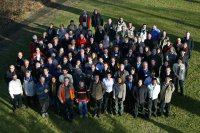 |
 |
|||||||||||||
|
|||||||||||||
|
|||||||||||||
|
A global project like the ILC depends on global cooperation. The contributors are scattered all over the world. Researchers cannot simply walk down the hall to get advice from a colleague because he is likely to sit somewhere half a world away. However, there is technology that helps scientists to cover these distances virtually: discussions in internet forums and regular telephone and video conferences are part of any scientistís everyday life.
But even in this digital age face-to-face meetings remain essential. This is why the ILD group met at DESY in Zeuthen near Berlin from 14 to 16 January. After the two detector concept groups GLD and LDC had merged to form the ILD concept last year the scientists saw each other at meetings in Hamburg and Chicago. The Zeuthen meeting however was the first dedicated one just for ILD people. During the three-day workshop the participants discussed the state of the ILD concept and plans for the future. And there were quite a number of participants! “With 119 participants, the attendance was about fifty percent more than what we anticipated,” said Hitoshi Yamamoto, formerly GLD. Ties Behnke, formerly LDC, was surprised about the run on the workshop: “With a future project like the ILC you never really know who will be there.” While Europe, being the host continent, was most strongly represented, a significant number of people had travelled from Asia and from the US. Yamamoto said that the results of the recent funding cuts were noticeable, adding “but anybody who may think that ILC has lost its momentum should have been at the meeting” as a comment on the positive atmosphere among the scientists and their motivation for the future. Yamamoto hopes that this mood is mirrored in the rest of the project: “The overall ILC schedule may be affected by the recent events in US and UK. But the general feeling is that the momentum we have is much too strong to have any significant slow-down.” The full agenda had the different sub-groups present the state of their research in order to determine what the final detector with all sub-detectors could look like and how it can be integrated with the accelerator. “At the moment these are all thought experiments - computer simulations,” said Behnke. He added: “It was very noticeable that quite a number of new studies were presented, based on detailed and realistic software simulations.” With the results from these studies available later this year the ILD community thinks that a realistic and complete case will be made for the detector concept. And these results are also supposed to find their way into the letter of intent (LOI) in the near future. The time plan for the LOIs had been the original reason for the merger of the two earlier detector concepts: the letters of the now three different concepts (ILD, SiD and 4th) were supposed to be submitted by October 2008. However, this date is likely to move because of the recent developments within the project. Nevertheless the ILD community agreed at their Zeuthen meeting that they want to continue with the preparation of the LOI: “The concrete roadmap for the LOI was established,” said Yamamoto. For Behnke, the LOI, likely to be around 100 pages strong, is another important step for the concept: “This common letter is something like an official declaration of intent for the community. We want to show the physics that we can achieve with the proposed detector and how it can be built.” The meeting was also the first time that the ILD community discussed their own organisation. They will meet again at the TILC08 in Sendai in March. Until then the scientists are sure to stay in contact via phone and video conferences. -- Jan Dreyling-Eschweiler |
|||||||||||||
| © International Linear Collider |

